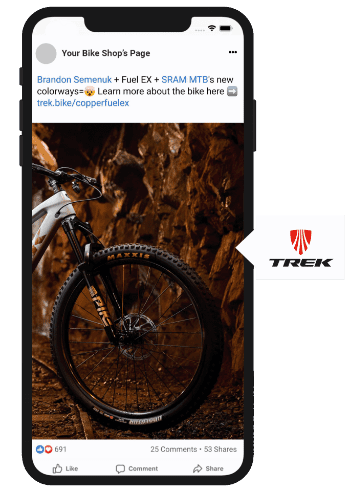Social Media Automation
for Bicycle Shops
Social media automation can power your bike shop’s ability to reach casual
to serious cyclists in your local area and turn them into customers.
Marketing to Cyclists
To successfully market bikes and your bike shop, you need to understand your customers. Chances are they research products and shop online, even if they shop in person, too. To reach them you need to maintain an online presence strategically designed to reach potential customers where they are, at the right time. You need to show the products you sell in their best light, and encourage shoppers to buy from you, rather than your competitor. Engage them in conversation with useful information, tips and tricks, discounts and promotions and your shop’s unique personality. One of the easiest, most cost effective ways to accomplish these tasks is with social media.


Social Media for Bike Shops
What should you consider as part of your bike shop social media strategy? First, you need to let them know you’re out there and what bicycle brands you carry. You will need to present the brands in a way that’s consistent with how they market themselves. Next, you will want to showcase specific product features and promotions. Finally, you will need to drive interested buyers to your website or your brick-and-mortar store where, with your sales and customer service skills, they will make a purchase.
The key to success with social media is to keep supplying it with content. You need to keep your feeds fresh but consistent. A content calendar and posting strategy will guide you in what to post and when.

Shift into High Gear with Automated Facebook Posting
Planning a social media content calendar — and sticking to it — requires commitment. When you’re busy running a bike shop, dealing with suppliers and customers, and possibly even planning events, you don’t have much time left over for marketing. Look for ways to create efficiencies.
Automated social posting can direct high quality visuals and copy from the bike brands you carry straight to your Facebook feed. ThumbStopper provides the platform and your brands provide the content. All you have to do is subscribe. The ThumbStopper platform pushes brand content to your feed, timing it for the best chances of engagement.
Take Control of Your Bike Shop Social Media Marketing
Cyclists are out there waiting to hear from your shop. While you can’t be everywhere at once, your social media accounts can — when supplied with a steady stream of quality content. Ensure that shoppers find you, know what bikes you carry, and want to engage with your digital presence. After all, that’s how today’s consumers make purchasing decisions. While you showcase your shop’s unique personality and involvement in your local community, ThumbStopper takes care of the heavy lifting by automating your social media content from your brands.
7 Out of 10 Customers are Influenced by Social Media.
Check out our 15 minute webinar on how to properly use social media to get more customers to come to your bike shop.
Brands We Work With
Featured Resources
CASE STUDY
How STIHL Canada Drove a Successful Co-Op Marketing Campaign Utilizing Marketing Technology
GUIDE
How to Get Retailers to Participate in Your Channel Marketing Program
Key Points:
- Companies should understand the Web Content Accessibility Guidelines (WCAG) to ensure their websites are accessible.
- Brands that concentrate on accessibility on social media demonstrate care for their customers and build a positive brand reputation.
- Brands should always consider inclusive design, such as plain, straightforward language, in their social media posts.
Accessibility may not be a term you usually associate with the internet and social media. You might picture wheelchair ramps, directional signs in braille, or sign language interpreters at live performances. The landmark Americans with Disabilities Act (ADA) of 1990 dictates the legal necessity of these and similar accommodations in public spaces. As we’ve come to rely on the internet for everything from entertainment to buying groceries, it’s become clear that the internet is now also a public space. It must be accessible to everyone. And like other applications of ADA, businesses that do not comply are liable for damages caused by inaccessibility.
The Web Content Accessibility Guidelines (WCAG) are an international set of standards to provide instruction on meeting accessibility needs. It’s important for companies to understand how this applies to their websites, especially if they engage in e-commerce. In terms of social media, the requirements are less concrete. But prioritizing accessibility on your company’s social media is essential to your reputation, even if the legal requirements are uncertain. We’ll look at why it’s important to your customers, how it affects the perception of your brand, and how to make these changes efficiently.
Social Media for All
The cornerstone of accessibility is inclusive design: products or experiences that are accessible for everyone regardless of disability. The most important place where this shows up is on company websites where most users expect to also find links to the brand’s social media profiles. Unfortunately, the overwhelming majority of websites are not accessible, despite the fact that the application of ADA to the internet is over 20 years old. Making websites accessible is a complex process without the use of specialized software like Accessibe or EqualWeb.
Unlike websites, making sure your social media is accessible is a straightforward, ongoing process. Every social platform has been quick to release optional accessibility features. These features are important to many users even if they don’t rely on them to use social media.
Making your social presence accessible tells users that your brand cares about people, not just profits. It’s the same idea as the push for the representation of different body sizes in fashion or more expansive skin tone ranges in beauty products. Brands that meet the needs of underrepresented groups endear themselves to others as well. And while optimizing your brand website for accessibility might be a larger project you aren’t ready to tackle yet, starting with your social media pages is a great way to show customers that you’re listening to their concerns.
Making Content Accessible
Shifting to accessible content means incorporating inclusive design into your creative process. The practice varies by type of media. For platforms that have graphics or videos with captions, it means not only adjusting each component but also being mindful of how they interact with each other.
For example, YouTube’s automatically generated closed captions and subtitles are often inaccurate. It's one of many examples where the caption generation software has issues picking up strong accents and mumbled words. This could be remedied with handcrafted video transcription services. If that’s not in the budget, the video creator could add their script or transcription to the video description.
None of the technology for accessibility is perfect yet. Teaching computers to digest complex information for human understanding is difficult, and the variations in disabilities further complicate it. The majority of adjustments creators need to make revolve around helping assistive technology better understand their content. Let’s look at how to make different kinds of content accessible.
Text
- Use plain language that’s easy to understand
- Avoid text in all caps
- Capitalize the first letter of each word in a hashtag, like #SocialMediaMarketing, a practice called camel-case
Videos
- Provide descriptive captions. Instead of just displaying the words people on-screen say, explain background noises and other sounds that are relevant to the scene.
- Add your own subtitles or enable auto-subtitles on the video platform of your choice
- Use captioning for live videos when possible
Graphics
- Use color contrast checkers to make sure low-vision people can see images
- Try not to completely rely on color to show contrast
- Add alternative text on each social platform
Distribute Accessible Content
Many users find their new favorite brand through social media. When disabled people (who make up 26% of the population according to the CDC) can’t access your brand’s social posts, you miss the opportunity to connect with a demographic that’s eager to engage in online communities. On a hyper-local level, that kind of connection goes even further.
That’s why ThumbStopper exists to help brands distribute their social content to their retailer network. Retailers can connect with their local audience - with your accessible, branded content - in a more personal way. And since content goes to their page automatically once they sign up, retailers can effortlessly promote your brand online while focusing on running their business.
Ready to see how ThumbStopper can help your brand improve its reach? Check out our brand reach calculator or book a demo.



